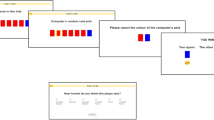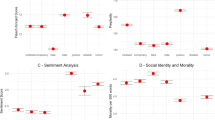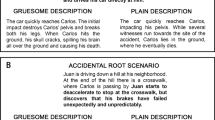Abstract
Decades of research have shown that people are poor at detecting deception. Understandably, people struggle with integrating the many putative cues to deception into an accurate veracity judgement. Heuristics simplify difficult decisions by ignoring most of the information and relying instead only on the most diagnostic cues. Here we conducted nine studies in which people evaluated honest and deceptive handwritten statements, video transcripts, videotaped interviews or live interviews. Participants performed at the chance level when they made intuitive judgements, free to use any possible cue. But when instructed to rely only on the best available cue (detailedness), they were consistently able to discriminate lies from truths. Our findings challenge the notion that people lack the potential to detect deception. The simplicity and accuracy of the use-the-best heuristic provides a promising new avenue for deception research.
This is a preview of subscription content, access via your institution
Access options
Access Nature and 54 other Nature Portfolio journals
Get Nature+, our best-value online-access subscription
$29.99 / 30 days
cancel any time
Subscribe to this journal
Receive 12 digital issues and online access to articles
$119.00 per year
only $9.92 per issue
Buy this article
- Purchase on Springer Link
- Instant access to full article PDF
Prices may be subject to local taxes which are calculated during checkout


Similar content being viewed by others
Data availability
All data are publicly available at https://osf.io/z26ar/.
Change history
20 April 2023
In the version of this article initially published online, there were typos in the bottom row, third and fourth columns of “Studies 8 and 9” where in the curernt “66.41% (Study 9)” and “59.14 (Study 9),” “Study 8” twice appeared; the HTML and PDF versions of the article are now updated.
References
Bond, C. F. & DePaulo, B. M. Accuracy of deception judgments. Pers. Soc. Psychol. Rev. 10, 214–234 (2006).
Bogaard, G., Meijer, E. H., Vrij, A. & Merckelbach, H. Strong, but wrong: lay people’s and police officers’ beliefs about verbal and nonverbal cues to deception. PLoS ONE 11, e0156615 (2016).
Aavik, T. et al. A world of lies. J. Cross Cult. Psychol. 37, 60–74 (2006).
Hartwig, M. & Bond, C. F. Why do lie-catchers fail? A lens model meta-analysis of human lie judgments. Psychol. Bull. 137, 643–659 (2011).
DePaulo, B. M. et al. Cues to deception. Psychol. Bull. 129, 74–118 (2003).
Luke, T. J. Lessons from Pinocchio: cues to deception may be highly exaggerated. Perspect. Psychol. Sci. 14, 646–671 (2018).
Sporer, S. L., Masip, J. & Cramer, M. Guidance to detect deception with the aberdeen report judgement scales: are verbal content cues useful to detect false accusations? Am. J. Psychol. 127, 43–61 (2014).
Weinberger, S. Airport security: intent to deceive? Nature 465, 412–415 (2010).
Hauch, V., Sporer, S. L., Michael, S. W. & Meissner, C. A. Does training improve the detection of deception? A meta-analysis. Commun. Res. 43, 283–343 (2016).
Street, C. N. H. & Richardson, D. C. The focal account: indirect lie detection need not access unconscious, implicit knowledge. J. Exp. Psychol. Appl. 21, 342–355 (2015).
Gigerenzer, G. & Brighton, H. Homo heuristicus: why biased minds make better inferences. Top. Cogn. Sci. 1, 107–143 (2009).
Kleinberg, B., van der Toolen, Y., Vrij, A., Arntz, A. & Verschuere, B. Automated verbal credibility assessment of intentions: the model statement technique and predictive modeling. Appl. Cogn. Psychol. 32, 354–366 (2018).
Gigerenzer, G., Todd, P. M. & the ABC Research Group. Simple Heuristics That Make Us Smart (Oxford Univ. Press, 1999).
Tversky, A. & Kahneman, D. Judgment under uncertainty: heuristics and biases: biases in judgments reveal some heuristics of thinking under uncertainty. Science 185, 1124–1131 (1974).
Dressel, J. & Farid, H. The accuracy, fairness, and limits of predicting recidivism. Sci. Adv. 4, eaao5580 (2018).
Salganik, M. J. et al. Measuring the predictability of life outcomes with a scientific mass collaboration. Proc. Natl Acad. Sci. USA 117, 8398–8403 (2020).
Gigerenzer, G. & Gaissmaier, W. Heuristic decision making. Annu. Rev. Psychol. 62, 451–482 (2011).
Johnson, M. K. & Raye, C. L. Reality monitoring. Psychol. Rev. 88, 67–85 (1981).
Nahari, G., Vrij, A. & Fisher, R. P. Exploiting liars’ verbal strategies by examining the verifiability of details. Leg. Criminol. Psychol. 19, 227–239 (2014).
Lakens, D. Calculating and reporting effect sizes to facilitate cumulative science: a practical primer for t-tests and ANOVAs. Front. Psychol. 4, 863 (2013).
Youden, W. J. Index for rating diagnostic tests. Cancer 3, 32–35 (1950).
Weinberger, S. Terrorist ‘pre-crime’ detector field tested in United States. Nature https://doi.org/10.1038/news.2011.323 (2011).
Boffey, D. EU border ‘lie detector’ system criticised as pseudoscience. The Guardian (2 November 2018).
Vrij, A., Fisher, R., Mann, S. & Leal, S. Detecting deception by manipulating cognitive load. Trends Cogn. Sci. 10, 141–142 (2006).
Kleinberg, B., Arntz, A. & Verschuere, B. Being accurate about verbal credibility assessment. Preprint at PsyArXiv https://doi.org/10.31234/OSF.IO/H6PXT (2019).
Evans, J. R. & Michael, S. W. Detecting deception in non-native English speakers. Appl. Cogn. Psychol. 28, 226–237 (2014).
Markowitz, D. M. & Hancock, J. T. in Handbook of Language Analysis in Psychology (eds M. Dehghani & R. L. Boyd) 274–284 (Guilford Press, 2022).
Ott, M., Choi, Y., Cardie, C. & Hancock, J. T. Finding deceptive opinion spam by any stretch of the imagination. In Proc. 49th Annual Meeting of the Association for Computational Linguistics: Human Language Technologies (eds Lin, D et al.) 309–319 (Association for Computational Linguistics, 2011).
Rudin, C. Why black box machine learning should be avoided for high-stakes decisions, in brief. Nat. Rev. Methods Primers 2, 81 (2022).
Verschuere, B., Schutte, M., van Opzeeland, S. & Kool, I. The verifiability approach to deception detection: a preregistered direct replication of the information protocol condition of Nahari, Vrij, and Fisher (2014b). Appl. Cogn. Psychol. 35, 308–316 (2021).
Levine, T. R., Daiku, Y. & Masip, J. The number of senders and total judgments matter more than sample size in deception-detection experiments. Perspect. Psychol. Sci. 17, 191–204 (2021).
Verigin, B. L., Meijer, E. H., Vrij, A. & Zauzig, L. The interaction of truthful and deceptive information. Psychol. Crime. Law 26, 367–383 (2020).
Oberlader, V. A. et al. Validity of content-based techniques to distinguish true and fabricated statements: a meta-analysis. Law Hum. Behav. 40, 440–457 (2016).
Acknowledgements
We thank A. El Feddali and V. Giannelli for their help with the Pilot Study, E. Wevers, R. Louterse and J. Wong for their help with Study 6, A. Lob for his help with Study 7 and Study 9, N. Jebriel and N. Roijakkers for their help with Study 8 and M. Vestjens and S. Wiechert for their help with Study 9. E.M. is supported by the Israel Institute for Advanced Studies. The funders had no role in study design, data collection and analysis, decision to publish or preparation of the paper.
Author information
Authors and Affiliations
Contributions
B.V. and E.M. conceptualized the study. C.-C.L., S.H., M.W., L.L., T.v.G., E.C., O.K.A., E.M. and B.V. were responsible for the methodology. C.-C.L., S.H., M.W., L.L., T.v.G., E.C. and O.K.A. were responsible for the investigation. B.V. and B.K. conducted the statistical analyses. B.V. and E.M. wrote the original draft. B.V., E.M. and B.K. reviewed and edited the paper.
Corresponding author
Ethics declarations
Competing interests
The authors declare no competing interests.
Peer review
Peer review information
Nature Human Behaviour thanks the anonymous reviewers for their contribution to the peer review of this work. Peer reviewer reports are available.
Additional information
Publisher’s note Springer Nature remains neutral with regard to jurisdictional claims in published maps and institutional affiliations.
Supplementary information
Supplementary Information
Supplementary Analyses, Methods, Figs. 1–6 and Table 1.
Rights and permissions
Springer Nature or its licensor (e.g. a society or other partner) holds exclusive rights to this article under a publishing agreement with the author(s) or other rightsholder(s); author self-archiving of the accepted manuscript version of this article is solely governed by the terms of such publishing agreement and applicable law.
About this article
Cite this article
Verschuere, B., Lin, CC., Huismann, S. et al. The use-the-best heuristic facilitates deception detection. Nat Hum Behav 7, 718–728 (2023). https://doi.org/10.1038/s41562-023-01556-2
Received:
Accepted:
Published:
Issue Date:
DOI: https://doi.org/10.1038/s41562-023-01556-2
This article is cited by
-
Verbal lie detection using Large Language Models
Scientific Reports (2023)



